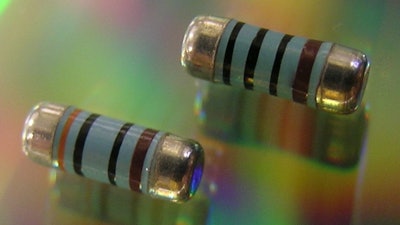
The rapid expansion of the smart grid has brought along with it an increase in the functionality of meters, and an increase in resistor requirements.
In addition to the hundreds of general-purpose resistors that are used in meters, there are also some new application-specific resistor requirements.

Input Protection
All meters require protection from external overloads, including protection from lightning strikes. Typically this is accomplished with a combination of a metal oxide varistor (MOV) for voltage protection and fusible wirewound burden resistor for current limiting.
The MOV can be surface mount or thru hole, and is available in a wide range of sizes depending on the level of protection required and the burden resistor used with it. Typical RMS voltages for an MOV are 150V, 250V, 300V, 385V and 575V.
Smart meters are typically operate at 900MHz and 2.4GHz for intelligent communication. This often requires a precision thin film resistor design. It may also require a specially designed wirewound for the burden resistor because the resonant frequency of the wirewound needs to be out of the communication frequency bands.
The fusible wirewound resistor size and power rating will vary with the level of protection required and the size of the MOV. Smaller MOVs typically require larger, more robust resistors. Typical fusible wirewounds with power ratings of 3 to 7 watts and resistance values ranging from 36 ohms to 150 ohms are regularly used.
Voltage Measurement
The metrology section of the meter measures the amount of power being used. In this application, a resistor network is used as a voltage divider. This network of resistors is typically made up of metal electrode leadless face (MELF) resistors with accuracy better than 1% and TCR better than 100 ppm.
In addition, these MELF resistors must demonstrate adequate stability in surviving surges as well stability under a wide range of environmental and electrical stresses. Metal film MELFs have a great combination of low thermal resistance, good pulse handling, low noise, and exceptional electrical and environmental stability.
Generally, designs will use series and parallel combinations of 4 to 8 MELF resistors usually in resistance values above 100K ohms. Another solution uses high voltage resistors in the place of MELF resistors. Parallel combinations of several high voltage resistors are used in conjunction with standard film resistors to provide the voltage division with the proper accuracy.
 Stackpole’s MLFA series of MELF resistors.
Stackpole’s MLFA series of MELF resistors.
Current Measurement
Current measurement is also a portion of the metrology section. The current measurement in conjunction with the voltage measurement provides the information for power usage along with power factor and reactive power. The measurement is typically done with a shunt resistor or current transformer.
When using a shunt resistor, it is normally an all-metal design with resistance values below 5 milliohm, and TCR as low as possible. Power ratings for the shunt resistor range from 1 to 5 watts. Stackpole’s HCS series is a great option for these shunt resistor designs.
 Stackpole’s HCS Series of high current shunt resistors.
Stackpole’s HCS Series of high current shunt resistors.
LED Display
Many of today’s smart meter designs have LED displays and digital registry. For those meters, there are several non-commodity resistors that are needed. Input protection is typically provided by a fusible wirewound in the 2W to 5W power range and in resistance values around 10 ohms.
Stackpole’s WWF and SP3A are ideal choices for this requirement. The LED driver buck converter typically uses current sense resistors in relatively higher resistance values (1ohm to 5ohm). Stackpole’s RMCF series and CSR/CSRN series are suitable choices for this application.
For higher current and higher efficiency designs these resistors may require metal element resistors. The DC-to-DC converter providing power to the LED string typically requires current limiting during power up and power down. Thick film chip resistors with high pulse power handling capability and defined voltage handling characteristics are an ideal solution and provide outstanding reliable performance in a relatively inexpensive SMD package.
New thick film resistors are available that utilize a unique design and manufacturing process to provide pulse withstanding many times greater than that of standard chip resistors. However, unlike standard chip resistors, the pulse handling is reliable and consistent.
In addition to the high pulse withstanding performance, the thick film technology will always fail open and safely when experiencing overloads beyond the specified capabilities of the part.
If you have technical questions, reach out to a product expert at [email protected].























